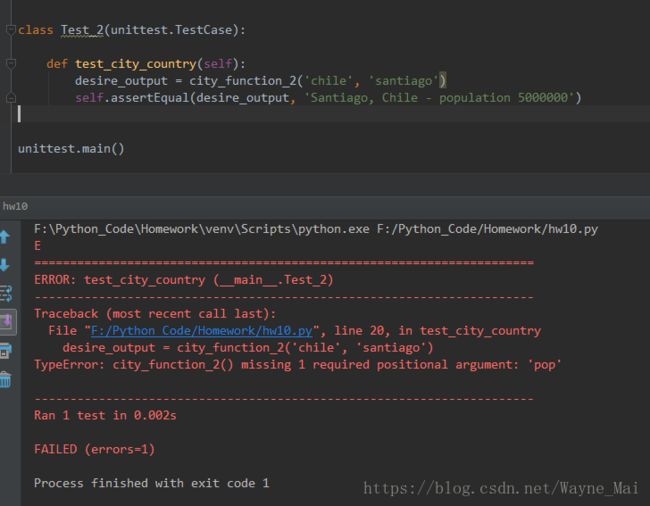Python入门与实践 Chapter 11 动手试一试
11-1 城市和国家 : 编写一个函数, 它接受两个形参: 一个城市名和一个国家名。 这个函数返回一个格式为City, Country 的字符串, 如Santiago, Chile 。 将
这个函数存储在一个名为city_functions.py的模块中。创建一个名为test_cities.py的程序, 对刚编写的函数进行测试(别忘了, 你需要导入模块unittest 以及要测试的函数) 。 编写一个名为test_city_country() 的
方法, 核实使用类似于’santiago’ 和’chile’ 这样的值来调用前述函数时, 得到的字符串是正确的。 运行test_cities.py , 确认测
试test_city_country() 通过了。
11-2 人口数量 : 修改前面的函数, 使其包含第三个必不可少的形参population , 并返回一个格式为City, Country - population xxx 的字符串,
如Santiago, Chile - population 5000000 。 运行test_cities.py, 确认测试test_city_country() 未通过。
修改上述函数, 将形参population 设置为可选的。 再次运行test_cities.py, 确认测试test_city_country() 又通过了。
再编写一个名为test_city_country_population() 的测试, 核实可以使用类似于’santiago’ 、 ‘chile’ 和’population=5000000’ 这样的值来调用
这个函数。 再次运行test_cities.py, 确认测试test_city_country_population() 通过了
11-3 雇员 : 编写一个名为Employee 的类, 其方法init() 接受名、 姓和年薪, 并将它们都存储在属性中。 编写一个名为give_raise() 的方法, 它默认将
年薪增加5000美元, 但也能够接受其他的年薪增加量。
为Employee 编写一个测试用例, 其中包含两个测试方法: test_give_default_raise() 和test_give_custom_raise() 。 使用方法setUp() , 以免在每个测试方法中都创建新的雇员实例。 运行这个测试用例, 确认两个测试都通过了。
如下所示,代码分成了两部分。第一部分是待测试文件,第二部分是测试文件。
要注意的是,输出是依次将测试代码各部分注释掉给出的,以便合乎题目的要求。
实现上述题目的代码如下:
def city_function(country, city):
return city.title() + ', ' + country.title()
def city_function_2(country, city, pop):
return city.title() + ', ' + country.title() + ' - population ' + pop
def city_function_pop(country, city, pop):
return city.title() + ', ' + country.title() + ' - population ' + pop
class Employee:
def __init__(self, name, family_name, salary):
self.name = name
self.family_name = family_name
self.salary = salary
def give_raise(self, add):
self.salary += addimport unittest
from testClass import *
"""
class Test(unittest.TestCase):
def test_city_country(self):
desire_output = city_function('chile', 'santiago')
self.assertEqual(desire_output, 'Santiago, Chile')
unittest.main()
"""
"""
class Test_2(unittest.TestCase):
def test_city_country(self):
desire_output = city_function_2('chile', 'santiago')
self.assertEqual(desire_output, 'Santiago, Chile - population 5000000')
unittest.main()
"""
class Test_3(unittest.TestCase):
def test_city_country(self):
desire_output = city_function_pop('chile', 'santiago', '5000000')
self.assertEqual(desire_output, 'Santiago, Chile - population 5000000')
class Employee_Test(unittest.TestCase):
def setUp(self):
nameList = ['name1', 'name2']
familyNameList = ['family1', 'family2']
salaryList = [1000, 1]
addList = [1000, 2]
self.salaryList = []
self.afterSalaryList = []
self.desireSalaryList = [1000, 1]
self.desireAfterSalaryList = [2000, 3]
for i in range(2):
e = Employee(nameList[i], familyNameList[i], salaryList[i])
self.salaryList.append(e.salary)
e.give_raise(addList[i])
self.afterSalaryList.append(e.salary)
def test_give_default_rise(self):
for i in range(2):
self.assertEqual(self.salaryList[i], self.desireSalaryList[i])
self.assertEqual(self.afterSalaryList[i], self.desireAfterSalaryList[i])
unittest.main()


